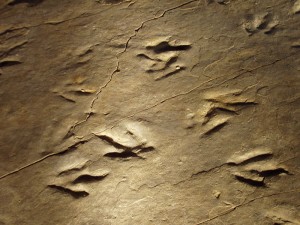By Owen Rogers
On August 23, 1966, bulldozer operator Edward McCarthy uncovered a fossilized Triassic lake bed in Rocky Hill. While excavating a path for the new Interstate 91 highway, McCarthy overturned a slab of sandstone and exposed six large, three-toed footprints. Closer inspection revealed that this former lake bed contained the most abundant display of Eubrontes tracks in North America.
Early (Very Early) Connecticut
Eubrontes giganteus was a large, carnivorous dinosaur that walked on two legs. The sedimentary composition of the Rocky Hill terrain preserved the beasts’ tracks made during the Jurassic period, nearly 200 million years ago. The discovery of these tracks shifted the state highway construction project toward archeological preservation, and when scientists confirmed the significance of this discovery, state officials approved the ancient lake bed be designated as a Connecticut state park.
The Connecticut Valley formed four billion years ago during a collision between land masses in the process of becoming the continents that we know today. The movement of tectonic plates caused patterns of separation and combination that rearranged the Earth’s surface. According to this theory of continental drift, the current seven continents formerly comprised a single massive continent called Pangaea. Over 250 million years ago, the African and North American continents collided and forced a layer of sedimentary ocean floor to the surface, depositing a unique geological terrain in present-day New England. Igneous rock, which forms during volcanic eruptions, identifies the original continental material and structures the terrain of both Eastern and Western Connecticut. In this formation process, molten rock rose from the Earth’s mantle and cooled to form the planetary crust. This intense heat disintegrated fossilized remains. On the other hand, sedimentary rock slowly accumulated from minerals and sediment on the ocean floor. The existence of a sedimentary sandstone lake bed in Rocky Hill, therefore, explains the presence of unique fossilized remains.
Preserving the Eubrontes Tracks

Dinosaur Tracks, Dinosaur State Park
Dinosaur State Park preserves the highest concentration of Eubrontes tracks believed to be in one location, with the fossilized lake bed holding approximately 2,000 of these three-toed tracks. Due to funding concerns, scientists reburied nearly 1,500 of the footprints for later exhumation, and the current exhibit now displays 500 tracks. There are no physical dinosaur remains at the park and the designation Eubrontes classifies the tracked footprint rather than actual fossil remains. Paleontologists linked the shape of these preserved footprints to a restored dinosaur skeleton from Arizona. The majority of the 12- to 14-inch-long, 11-inch-wide tracks compare to the Dilophosaurus, a Jurassic-era dinosaur that walked the Earth 200 million years ago.
Upon discovery of Rocky Hill’s unprecedented concentration of Eubrontes tracks, paleontologists, geologists, and state officials acted quickly to ensure the fossils’ preservation. On August 26, 1966, state troopers erected a snow fence around the lake bed to protect the fossils from amateur collectors. One month later, Governor John Dempsey approved the property as a Connecticut State Park.
The State Finance Committee diverted the construction of Route 91 and allocated funding for the preservation of the unearthed lake bed. Coating the lake-bed surface with layers of plastic sealer and vinyl sheeting, specialists took precautions to maintain the integrity of these fossil remains. After two years of restorative efforts, scientists completed the surface of the lake-bed exhibit. Opened to the public in 1968, an inflatable dome enclosed the tracks and protected the exhibit from harsh weather and erosion, but the dome collapsed many times until it was taken down in 1975. The park closed for three years until a rigid structure was set in place over the tracks.
Community Rallies to Support Park
The failure of the inflatable dome exposed the financial constraints of the park, so the Rocky Hill community formed the Friends of Dinosaur Park and Arboretum in 1976 to supplement the existing state budget. Concurrent with that year’s national bicentennial, the preservation of a prehistoric Connecticut site expanded the timeline of the Rocky Hill area. The organization recognized the unique nature of the discovery and responded with public interest and cooperation.
From the onset of discovery, the fossilized tracks in Rocky Hill encouraged an interest in local history. Given that the state budget provides Dinosaur State Park with a stipend less than the cost of programming, the Friends of Dinosaur State Park and Arboretum streamline museum support through initiatives such as the Friends Bookshop. Because school tours and community programs are fundamental elements in the Dinosaur State Park history outreach, sales profits from the store sustain educational programs, trips, guided walks, lectures, and slide presentations.

Life-sized model of Dilophosaurus donated by Friends of Dinosaur State Park and Arboretum
The group significantly improved the information available onsite through donated displays of materials related to dinosaurs. In 1981, the group donated the world’s first reconstructed Dilophosaurus, later donating a reconstructed Rutiodon, a prehistoric crocodile, and Metoposaurus, a prehistoric amphibian. As a background for these life-sized models, the Friends of Dinosaur State Park and Arboretum donated murals depicting what scientists believe the terrain surrounding the lake-bed may have looked like in the Triassic and Jurassic periods.
The Eubrontes footprint became the Connecticut state fossil in 1991. The Friends of Dinosaur State Park and Arboretum organization acts as the financial caretaker for the site, expands and maintains the quality of museum exhibits and increases the awareness of a pre-human past.
Owen Rogers is a public historian who received his oral history training at Central Connecticut State University, where he works for the Veterans History Project, an archive partner with the Library of Congress.








